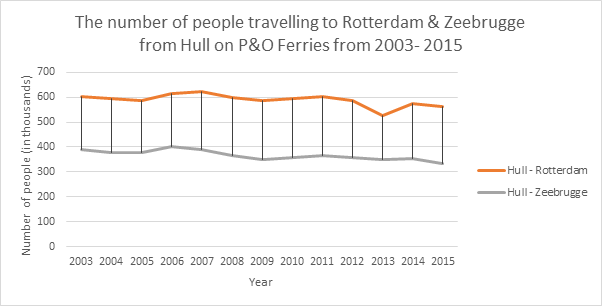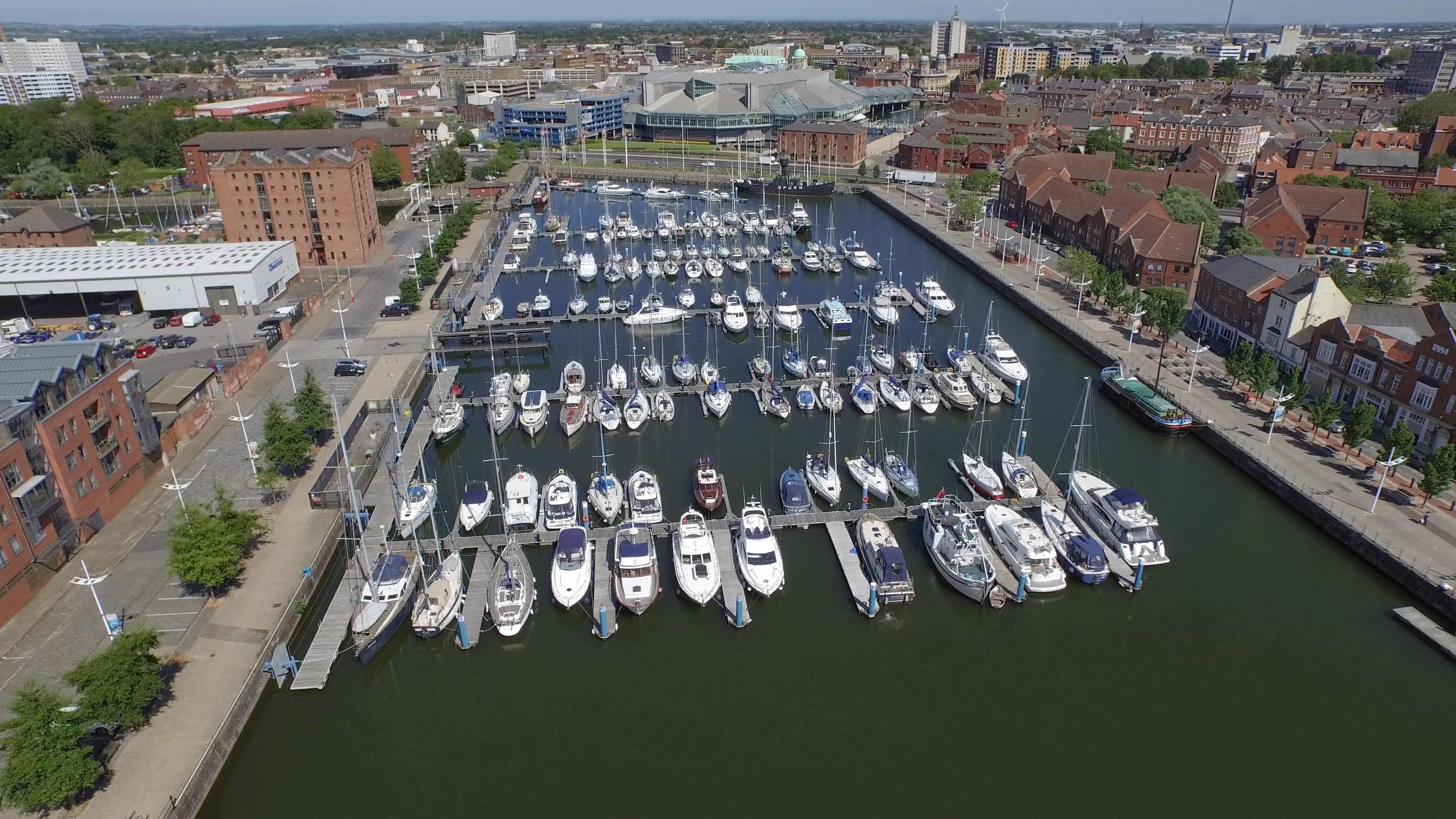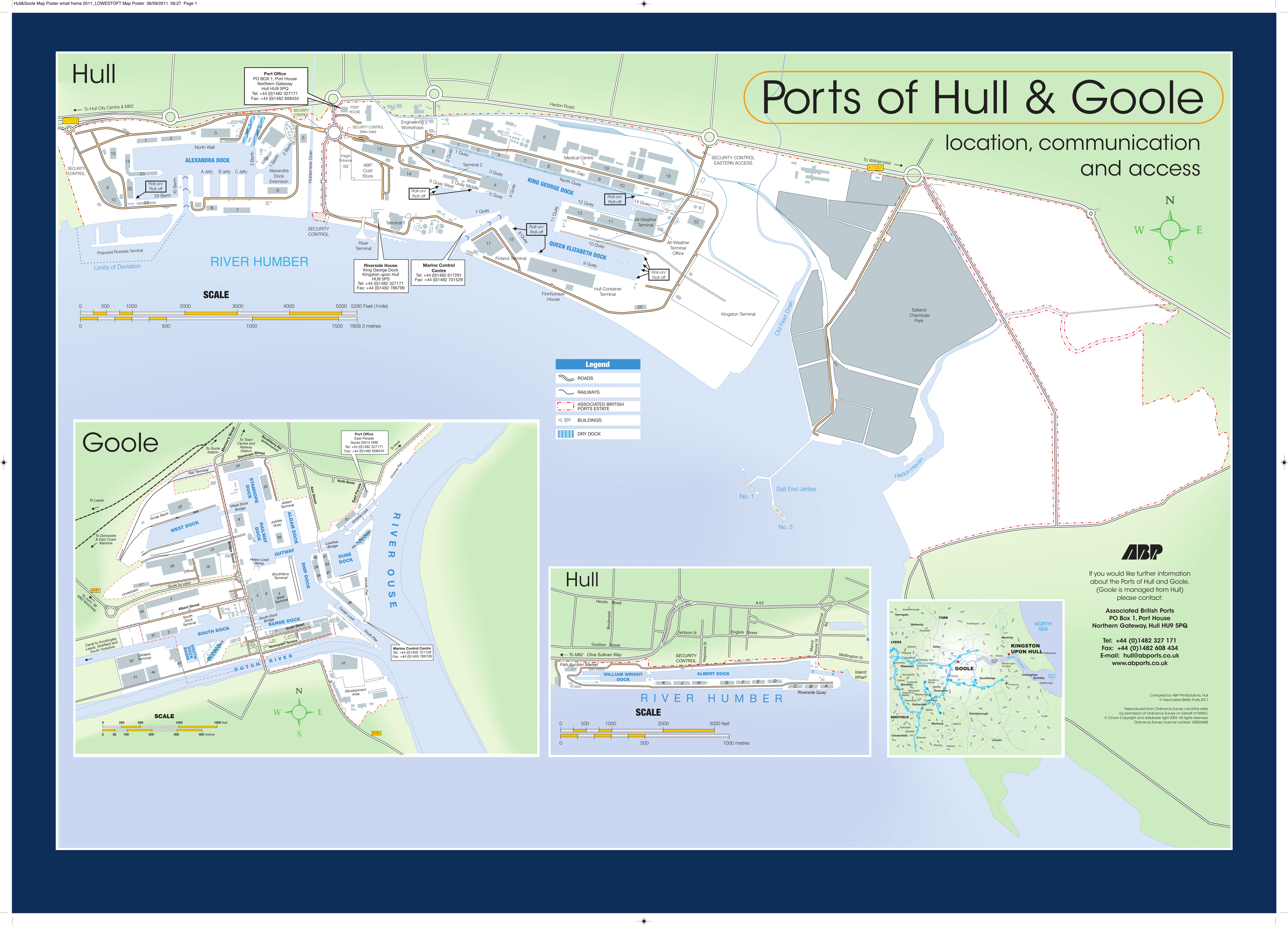Do you think there is some data we are missing or do you have data you would like to present?
If so contact Nick Richards at: N.Richards@hull.ac.uk
Hull
This port handles:









The Port of Hull has been in existence since the 12th century and is situated on the North bank of the River Humber and the junction with the River Hull. It has been involved in international trade since, when wool was exported from nearby Meaux Abbey. Between the 14th and 18th centuries Hull became more heavily involved in brisk trade with ports on the Baltic Sea, and import and export continues to this day and has grown dramatically to encompass many commodities to and from many destinations such as Rotterdam.
Hull is the UK’s first fully-enclosed freight handling facility which can operate in all weathers and can handle different cargoes in all weather conditions. The Port can handle a number of different types of freight including:
- Containers – can handle over 100,000 containers each year
- Dry bulk – can handle a wide range of dry bulk freight, including animal feed and cocoa
- Paper and forest products – the Finland Terminal has more than 70,000 sq m of covered storage for paper products
- Fresh produce and perishable – Hull has 24,000 cubic metres of cold storage which can hold 10,000 pallets and can freeze products down to -25°C
- Other general cargo – storage facilities of 230,000 sq m of shed storage and 65 hectares of open storage
- Liquid bulk – the port can handle a wide range of liquids including edible oils and chemical products. The port has also got the facility to transfer liquids directly from ships into road tankers or barges.
- RORO (Roll on, Roll off) and LOLO (Lift on, Lift off) and passenger services – Hull is the only port in the Humber Estuary to operate a passenger service
The size of the port measures approximately 65 hectares of open storage and over a hundred and twenty thousand square metres of covered storage, with refrigerated storage also available. Annual tonnage through the port is over 9 million tonnes. Lifting equipment includes 3 container cranes with a maximum lift of 40 tonnes, and rail and mobile harbour cranes with capacities of 15 tonnes and 100 tonnes respectively.
As well as handling vehicles, Hull boasts capacity to handle many other commodities from grain through to petroleum products, steel and hazardous materials. The enclosed docks can accommodate vessels with a maximum length, beam and draft of 196m, 25.5m and 10.4m respectively.
Connectivity is well served with Humberside airport 40km away, connections to passenger rail only 4km away and close connections to motorway and inland waterway networks, giving good access to the rest of the UK mainland and other smaller ports upstream.
From the 1st of May 2016 ABP took over the operating of the Hull Container Terminal from PD Ports and announced an investment of £15 million into the terminal which is used by Samskip. The Terminal is located in the Queen Elizabeth Dock on the east of the City. The 30-acre terminal handles over 100,000 containers and receives vessels from all the UK and mainland Europe including Grangemouth and Rotterdam. The investment is aimed at improving the infrastructure and equipment at the terminal. To improve the equipment, two thirds of the money (10m) were used for bringing in two Liebherr gantry cranes which will vastly shorten the time it takes to unload and container vessels. Also as part of the investment in the equipment for the terminal 21 reach stackers, tractors and trailers were purchased to aid in cutting down the time it takes to move containers around the terminal. Also the investment allowed ABP to take on 39 staff that had worked in the terminal when it was owned by PD ports.
| Country | City | Carrier | Service Type | Frequency/Week |
|---|---|---|---|---|
| Belgium | Zeebrugge | P&O Ferries | RORO | 7 |
| Belgium | Antwerp | Finnlines | RORO/LOLO | 1 |
| Belgium | Antwerp | Thor Shipping | RORO/LOLO | 2 |
| Finland | Helsinki | Finnlines | RORO/LOLO | 2 |
| Finland | Kotka | Finnlines | RORO/LOLO | 2 |
| Finland | Rauma | Finnlines | RORO/LOLO | 2 |
| Iceland | Reydarfjordur | Cargow | LOLO | 0 |
| Netherlands | Amsterdam | Finnlines | RORO/LOLO | 1 |
| Netherlands | Velsen | Thor Shipping | LOLO | 2 |
| Netherlands | Rotterdam | Samskip | LOLO | 5 |
| Netherlands | Rotterdam | P&O Ferries | RORO | 7 |
| Russia | St Petersburg | Finnlines | RORO/LOLO | 1 |
| Sweden | Sodertalje | Thor Shipping | LOLO | 2 |
| Sweden | Vasteras | Thor Shipping | LOLO | 2 |
| Sweden | Oxelosund | Thor Shipping | LOLO | 2 |
| Sweden | Skelleftehamn | Ahlmark Line | LOLO | 4 |
| Sweden | Iggesund | Ahlmark Line | LOLO | 4 |
| Sweden | Ala | Ahlmark Line | LOLO | 4 |
| Belgium | Ghent | i-Motion | LOLO | 3 |
| Top 10: | Trade Type: | Rank by: | Month: | Year: | ||||||
|---|---|---|---|---|---|---|---|---|---|---|
| Compare: | Month: | Year: |
Port Assets
| No. of the Quays/Docks/Terminals | No. of Berths | Total Length of Quays (metres) | Average Tonnage Annually (in millions) | Average TEU's Annually (x1000) | Yard area/Port area (in acres) | Characteristics of Max Vessel Size Capable | Cargo Handling Facilities | Commodities Handled |
|---|---|---|---|---|---|---|---|---|
| 11 | 10+ | 13358 | 10 | 227 | 3,000 |
Beam: 25.5 metres LOA: 196 metres Draft: 10.4 metres DWT: 34,000 |
Cranes: Container: 3 max 40T Rail mounted: 32 max 15T Mobile harbour crane: 5 100T (max) Floating: 1 max 25Tv Ro-ro 11 enclosed ro-ro terminals
|
Containers (lo/lo), Unit loads (ro/ro), Vehicles/wheeled cargoes, Passengers, Dry bulks, Grain/Feedstuffs, Fruit/Vegetables, Refrigerated products, Hazardous cargoes, Forest products, Oil/Petroleum, Other liquid bulk, Steel offshore, General cargo, Project cargo (heavy lift), Fish |
Terminal Information
| Terminals | Cargo Handled | Services & Operators |
|---|---|---|
| Riverside Terminal No. 1 | Trailers (RORO) | P&O Ferries |
| King George Dock | Trailers (RORO) | P&O Ferries |
| Hull Container Terminal | Containers, Refrigerated Cargo | Samskip, McAndrews, PD Ports |
| King George Dock-AAK | Edible Oils/Palm Oils | AAK-UK |
| King George Dock-Rate&Lyle/Westway | Mollases | Westway Terminals |
P&O Ferries operate two daily services to Zeebrugge and Rotterdam. There are also return services from Zeebrugge and Rotterdam back to Hull on a daily basis. Most of the services operate over night, setting off around 8pm and arriving at their destination the next morning at about 8am. These services carry both passengers and Ro-Ro freight, also the service can take passenger’s vehicles. In Hull the ferry docks at King George Dock which is located to the East of the city in the main port area.
| Destination | Frequency | Return Service | Crossing Time |
|---|---|---|---|
| Zeebrugge | 7 per week | Yes | 12 hours |
| Rotterdam | 7 per week | Yes | 12 hours |
 As the graph shows the number of people using the ferry services to travel between Hull, Rotterdam and Zeebrugge has remained about the same since 2003. The Ferry services are a vital part of linking the UK with the rest of Europe and is an important trade route
As the graph shows the number of people using the ferry services to travel between Hull, Rotterdam and Zeebrugge has remained about the same since 2003. The Ferry services are a vital part of linking the UK with the rest of Europe and is an important trade route
Hull Marina

Hull Marina is located in the centre of Hull on the River Humber. The City Centre is only a short walk away from the Marina and Princes Quay, one of the major shopping centres in Hull, is only over the road. The Marina is well connected to the road network that leads in and out of the City by the A63 which leads to the main motorway network in the UK. The Marina is an excellent location to start a voyage to Northern Europe and the City of Hull has ferries to Rotterdam and Zeebrugge.
Hull Railway Station is only a short walk away from the Marina and the Station has good links to stations across the UK. The location of the Marina is near the Old Town which has been redeveloped into one of the most popular areas in the City like the new Humber Street development.
Hull Marina has a number of mooring products they offer to people including:
- Residential Moorings
- Leisure Moorings
- Storage Berths
- Visitor Moorings
- Visitor Moorings
- Caravan Storage
- Hard Standing
- 50ft Boat Hoist
- Boat Repairs and Marine Engineers
- Free Car Park (for berth holders and their visitors)
The Marina has a wide number of facilities for vessels in the Marina, to see what facilities are available, visit bwml.co.uk/hull-marina/
Contact details:
Hull Marina
Warehouse 13
Kingston Street
Hull
HU1 2DQ
01482 609960



